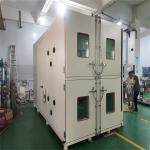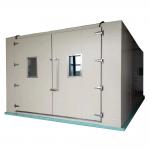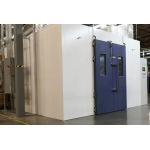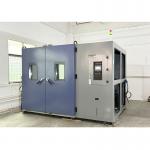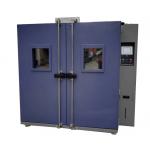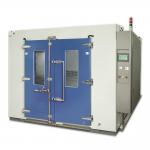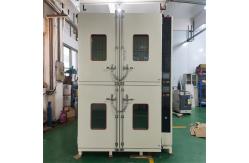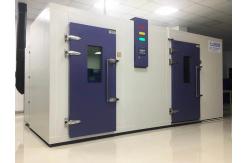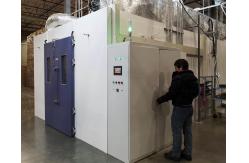In the modern home, appliances have become an essential part of our
daily lives, simplifying tasks and enhancing comfort. However, to
ensure their long-term reliability and optimal performance, it is
crucial to subject them to rigorous environmental testing. The
Customized Walk-In Environmental Chamber for Home Appliances
emerges as a powerful tool in this regard, providing a controlled
and simulated environment that mimics the diverse conditions these
appliances may encounter. This state-of-the-art chamber is specifically designed to test a
wide range of home appliances, including refrigerators, washing
machines, dishwashers, air conditioners, and televisions. It caters
to appliance manufacturers, research institutions, and quality
control laboratories. The primary objective is to evaluate how
these appliances function and endure under various environmental
stressors such as temperature fluctuations, humidity levels, and
even dust and chemical exposures. By doing so, manufacturers can
identify potential weaknesses in their products and make necessary
improvements, ultimately delivering more durable and efficient home
appliances to consumers. - Spacious and Sturdy Construction
- The walk-in chamber is constructed with a heavy-duty framework,
typically made of corrosion-resistant stainless steel or
high-strength alloy. This ensures its durability and stability,
allowing for the accommodation of large and bulky home appliances.
The interior is designed to provide a controlled and isolated
environment. It is lined with a non-reactive and heat-insulating
material to prevent any interference with the testing process. The
door is engineered with a reliable sealing mechanism, incorporating
a high-quality gasket and a multi-point locking system, ensuring an
airtight enclosure. The chamber also features a large viewing
window made of toughened glass, allowing for visual inspection of
the testing process without compromising the integrity of the test
environment.
- Precision Environmental Control Systems
- Temperature Control: Capable of maintaining a wide temperature
range, from -30°C to +60°C, with an accuracy of ±0.5°C. It utilizes
advanced refrigeration and heating technologies, such as
industrial-grade compressors and high-capacity heating elements.
The control system incorporates a feedback loop, with multiple
temperature sensors strategically placed throughout the chamber,
ensuring uniform temperature distribution. The user-friendly
control panel allows for precise programming of temperature
profiles, including rapid temperature changes and extended soak
times, replicating real-world conditions like the cold environment
of a freezer compartment or the heat generated during the operation
of a dryer.
- Humidity Control: The humidity control system can achieve humidity
levels from 10% to 95% RH (Relative Humidity), with an accuracy of
±3% RH. It employs a combination of steam injection and
dehumidification techniques, along with a carefully designed air
circulation system. Humidity sensors continuously monitor the
internal environment, and the control system adjusts accordingly to
create the desired humidity levels. This is essential for testing
the effects of moisture on appliances, such as the rusting of metal
parts in a humid bathroom or the performance of electronic
components in a humid climate.
- Dust and Particulate Simulation: To assess the impact of dusty
environments on home appliances, the chamber is equipped with a
dust injection system. It can introduce controlled amounts of
various types of dust, such as silica dust or household dust, into
the testing environment. This allows for the study of how
appliances like air purifiers, vacuum cleaners, and the cooling
fans of electronic devices handle the ingress of such contaminants.
The system also includes a filtration mechanism to prevent the dust
from escaping and contaminating the surrounding area.
- Chemical Exposure Testing: The chamber can also simulate chemical
exposures that appliances may face in a household setting. It can
introduce common household chemicals, such as detergents, cleaning
agents, and even food and beverage spills, in a controlled manner.
This enables the evaluation of how appliance surfaces, seals, and
internal components resist corrosion and degradation caused by
these chemicals. The chamber is designed with proper ventilation
and drainage systems to manage the chemical residues and fumes.
- Advanced Instrumentation and Data Acquisition
- The chamber is outfitted with a comprehensive suite of sensors and
instrumentation. In addition to temperature and humidity sensors,
it includes sensors for measuring power consumption, vibration, and
noise levels of the tested appliances. These sensors are connected
to a state-of-the-art data acquisition system that records and
stores all the relevant data. The data acquisition system offers a
high sampling rate, typically ranging from 50 to 500 samples per
second, ensuring that even the most rapid changes in environmental
conditions or appliance performance are accurately captured. The
collected data can be accessed and analyzed in real-time or
retrieved later for in-depth studies. The system is also compatible
with appliance industry-specific data analysis software, enabling
the generation of detailed reports and graphical representations of
the test results.
- Safety and Compliance Features
- The Customized Walk-In Environmental Chamber is designed with
multiple safety features. It has an automatic shutdown system in
case of any critical malfunction, such as overheating,
over-humidity, or excessive power consumption. The chamber is also
equipped with a fire suppression system, which can quickly
extinguish any potential fires that may occur due to electrical
faults or chemical reactions. The ventilation system is designed to
remove any harmful gases or fumes generated during testing,
protecting the operators and the surrounding environment.
Additionally, the chamber complies with relevant appliance testing
standards and regulations, ensuring that the testing procedures are
reliable and recognized within the industry.
- Chamber Size and Capacity: The walk-in chamber is available in various sizes, with interior
volumes ranging from a few cubic meters to larger configurations
suitable for testing multiple large appliances simultaneously. For
example, a smaller chamber might have an interior volume of 5 cubic
meters, while a larger one could be 20 cubic meters or more. The
interior dimensions are optimized for proper air circulation and
uniform environmental parameter distribution, ensuring that all
parts of the tested appliances are effectively exposed to the
simulated conditions.
- Temperature Cycling Rate: Can perform temperature cycles at a rate of 2 to 4 cycles per
day, depending on the specific test requirements. For example, it
can rapidly cool from +40°C to -10°C in a matter of minutes and
then heat back up, subjecting the appliances to significant thermal
stress, which is essential for evaluating thermal fatigue
resistance.
- Humidity Cycling Rate: The humidity can be cycled within 20 to 40 minutes, allowing for
the simulation of rapid changes in moisture conditions, such as
transitioning from a dry living room to a humid kitchen
environment.
- Dust Concentration and Exposure Time: The dust injection system can introduce dust concentrations
ranging from 10 milligrams per cubic meter to 1000 milligrams per
cubic meter, and the exposure time can be set from a few hours to
several days, depending on the desired test severity.
- Chemical Concentration and Application Method: The chamber can introduce chemical concentrations ranging from 1%
to 10% (by volume) of common household chemicals, and the
application method can be adjusted to mimic spills, sprays, or
long-term exposures.
- Data Acquisition Rate: The data acquisition system samples sensor data at a rate of 200
samples per second, ensuring that even the most minute and rapid
changes in temperature, humidity, power consumption, vibration, or
other parameters during the test are accurately recorded and can be
analyzed in detail. This high sampling rate provides valuable
insights into the performance and potential failure modes of the
home appliances.
- Compliance with Appliance Standards: Complies with a range of appliance industry standards, such as
IEC 60335 for safety and performance testing of household and
similar electrical appliances. This ensures that the testing is
conducted in a consistent and recognized manner, facilitating
market access and compliance with regulatory requirements for home
appliances.
|
